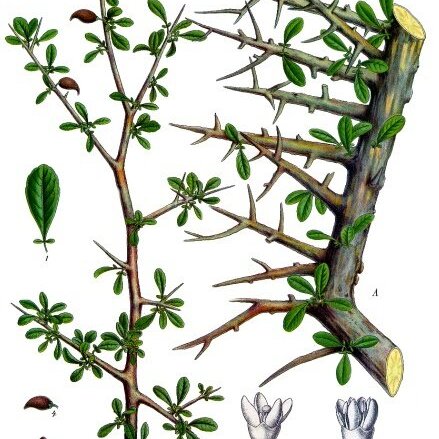Spiny almost glabrous shrub or small tree, usually with a distinct, though short trunk, up to 4 m. tall; outer bark silvery, whitish or bluish grey, peeling in large or small papery flakes from the greener under-bark; exudate hardly scented, viscid, producing a hard translucent yellowish gum-resin; all branchlets spine-tipped.. Leaves chartaceous, greyish green or glaucous, very variable; petiole 1–10 mm. long; a few lateral leaflets, sometimes very minute, may nearly always be found on both long-and short-shoot leaves, but most leaves may be without them or they may be up to half the size of the terminal leaflet, which maybe elliptic, spathulate or lanceolate, attenuate, cuneate, rounded or truncate at the base, rounded or acute apically, 6–44 mm. long, 3–20 mm. wide, with 3–4 rather weak main veins on each side, ultimate vein network obscure; margin entire or with up to 6 rather large broad teeth on each side.. Male flowers usually precocious, 2–4 together in dichasial cymes 3–4 mm. long which are often sparsely glandular; bracteoles pale brown, ovate-triangular, 0.5–0.7 mm. long and wide, often lightly attached at the base and forming a fragile detachable collar; receptacle beaker-shaped, ± 2 mm. deep and 2.3 mm. wide; calyx-tube ± 1 mm., lobes ovate-triangular 1.5 mm. long; petals oblong, tapering, pointed and recurved at the tip, 4.5 mm. long, 1.5 mm. wide; filaments 1.4 and 1.2 mm., anthers 1.2 and 1.0 mm. long.. Fruits 1–2 together on jointed stalks 2–4 mm. long, flattened, ovoid, markedly beaked, ± 12.5 mm. long (including a 2.5 mm. beak) × 6.3 × (1.6 + 3.5) mm.; pericarp 2-valved; pseudaril variable, usually with two large broadly oval facial lobes and much reduced narrower sutural lobes; occasionally the 4 lobes may be subequal rather short and rounded; stone smooth or with low, gentle swellings, ovoid, cordate at the base, flattened, often with a groove down the centre of each face, ± 7 × 5 × (1 + 2) mm.; occasionally both locules maybe fertile, a stone of this kind measured 7 × 5.7 × (2 + 2) mm.; apical pits minute; germination shield large but often faintly demarcated.. Fig. 4/16–18, p.16.
More
A spiny tree that loses its leaves. It grows 5 m high and spreads 1.5 m wide. The leaves have 3 leaflets. They are oblong to oval. The end leaflet is about 1 cm long. The flowers are yellow-red and have 4 petals. The fruit are narrowly oval and 7 mm long.
The gum or resin is used to flavour soft drinks, soups, baked goods, puddings, candy and chewing gum. It is used in Swedish bitters-a tonic drink.

